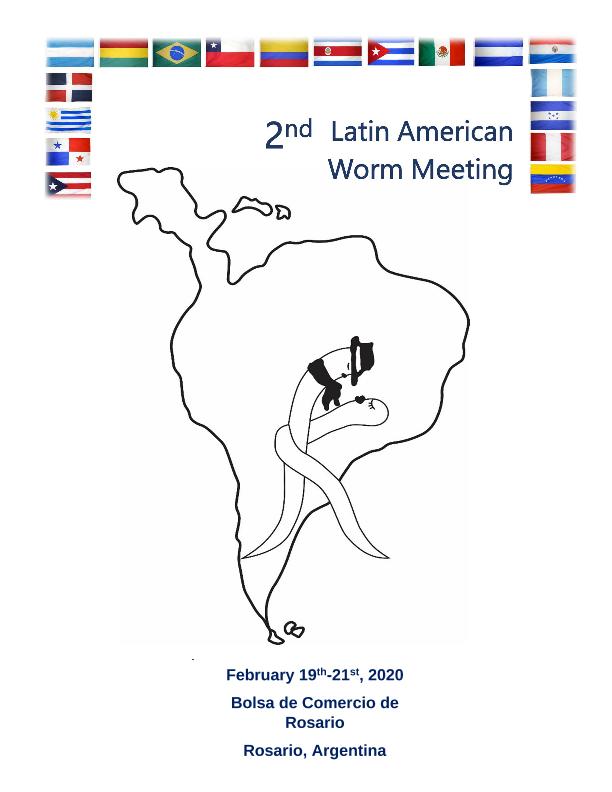Mostrar el registro sencillo del ítem
dc.contributor.author
Blanco, Maria Gabriela

dc.contributor.author
Zabala, Agustina
dc.contributor.author
Alkema, Mark J.
dc.contributor.author
De Rosa, María José
dc.contributor.author
Rayes, Diego Hernán

dc.date.available
2023-04-25T22:00:44Z
dc.date.issued
2020
dc.identifier.citation
Neural modulation of foraging strategies in C. elegans; II Latin American Worm Meeting; Rosario; Argentina; 2020; 17-17
dc.identifier.uri
http://hdl.handle.net/11336/195364
dc.description.abstract
Despite the intermodulation between serotonergic and adrenergic signals is crucial throughout the animal kingdom, the molecular and cellular mechanisms underlying this interrelation are poorly understood. Given its simplicity and the highly conserved neurological pathways, Caenorhabditis elegans is a powerful model organism that can be used to provide insights into the neural circuits linking 5-TH and catecholamines. When food-deprived worms encounter food, 5-HT is released to slow-down their locomotion and to stimulate pharyngeal pumping. In contrast, Tyramine (TA) and Octopamine (OA), invertebrate counterparts for adrenaline and noradrenaline, stimulate locomotion and decrease pharyngeal pumping. We found that well-fed tdc-1 (unable to synthesize TA and OA) and tbh-1 (unable to synthesize OA) null mutants are hypersensitive to the slowing-down response upon food encounter, resembling starved worms. Moreover, exogenous TA and OA recover the increased slowing-down locomotion of tdc-1 null mutants, suggesting that both, TA and OA, antagonize 5HTdependent food-related behaviors. Furthermore, our calcium imaging recordings showed that the peak of activity of serotoninergic neurons (ADF and NSM) upon encountering food is significantly higher in a tdc-1 null mutant background. We also found that tdc-1 null mutants are hypersensitive to the paralysis produced by exogenous 5-HT. Therefore, we are using this assay to evaluate the paralysis of the different TA and OA null receptor mutants to identify which receptors are involved in this antagonism. Taken together, these results suggest that TA and OA counteract with 5- HT by driving opposing food-related behaviors and by inhibiting 5-HT release
dc.format
application/pdf
dc.language.iso
eng
dc.publisher
Latin American Worm Meeting
dc.rights
info:eu-repo/semantics/openAccess
dc.rights.uri
https://creativecommons.org/licenses/by-nc-sa/2.5/ar/
dc.subject
C. elegans
dc.subject
biogenic amines
dc.subject
tyramine
dc.subject
crosstalk
dc.subject
serotonin
dc.subject
food-related behaviors
dc.subject.classification
Bioquímica y Biología Molecular

dc.subject.classification
Ciencias Biológicas

dc.subject.classification
CIENCIAS NATURALES Y EXACTAS

dc.title
Neural modulation of foraging strategies in C. elegans
dc.type
info:eu-repo/semantics/publishedVersion
dc.type
info:eu-repo/semantics/conferenceObject
dc.type
info:ar-repo/semantics/documento de conferencia
dc.date.updated
2023-02-07T09:59:26Z
dc.journal.pagination
17-17
dc.journal.pais
Argentina

dc.journal.ciudad
Rosario
dc.description.fil
Fil: Blanco, Maria Gabriela. Consejo Nacional de Investigaciones Científicas y Técnicas. Centro Científico Tecnológico Conicet - Bahía Blanca. Instituto de Investigaciones Bioquímicas de Bahía Blanca. Universidad Nacional del Sur. Instituto de Investigaciones Bioquímicas de Bahía Blanca; Argentina. Universidad Nacional del Sur. Departamento de Biología, Bioquímica y Farmacia; Argentina
dc.description.fil
Fil: Zabala, Agustina. Consejo Nacional de Investigaciones Científicas y Técnicas. Centro Científico Tecnológico Conicet - Bahía Blanca. Instituto de Investigaciones Bioquímicas de Bahía Blanca. Universidad Nacional del Sur. Instituto de Investigaciones Bioquímicas de Bahía Blanca; Argentina. Universidad Nacional del Sur. Departamento de Biología, Bioquímica y Farmacia; Argentina
dc.description.fil
Fil: Alkema, Mark J.. University Of Massachussets. Medical School. School Of Medicine. Departament Of Neurology; Estados Unidos
dc.description.fil
Fil: De Rosa, María José. Consejo Nacional de Investigaciones Científicas y Técnicas. Centro Científico Tecnológico Conicet - Bahía Blanca. Instituto de Investigaciones Bioquímicas de Bahía Blanca. Universidad Nacional del Sur. Instituto de Investigaciones Bioquímicas de Bahía Blanca; Argentina. Universidad Nacional del Sur. Departamento de Biología, Bioquímica y Farmacia; Argentina
dc.description.fil
Fil: Rayes, Diego Hernán. Consejo Nacional de Investigaciones Científicas y Técnicas. Centro Científico Tecnológico Conicet - Bahía Blanca. Instituto de Investigaciones Bioquímicas de Bahía Blanca. Universidad Nacional del Sur. Instituto de Investigaciones Bioquímicas de Bahía Blanca; Argentina. Universidad Nacional del Sur. Departamento de Biología, Bioquímica y Farmacia; Argentina
dc.relation.alternativeid
info:eu-repo/semantics/altIdentifier/url/https://acacimesfe.org/actividades/reuniones/reuniones-2020/2nd-latin-american-worm-meeting-february-19-21-2020-rosario/
dc.conicet.rol
Autor

dc.conicet.rol
Autor

dc.conicet.rol
Autor

dc.conicet.rol
Autor

dc.conicet.rol
Autor

dc.coverage
Internacional
dc.type.subtype
Congreso
dc.description.nombreEvento
II Latin American Worm Meeting
dc.date.evento
2020-02-19
dc.description.ciudadEvento
Rosario
dc.description.paisEvento
Argentina

dc.type.publicacion
Journal
dc.description.institucionOrganizadora
Latin American Worm Meeting
dc.source.revista
II Latin American Worm Meeting
dc.date.eventoHasta
2020-01-21
dc.type
Congreso
Archivos asociados
